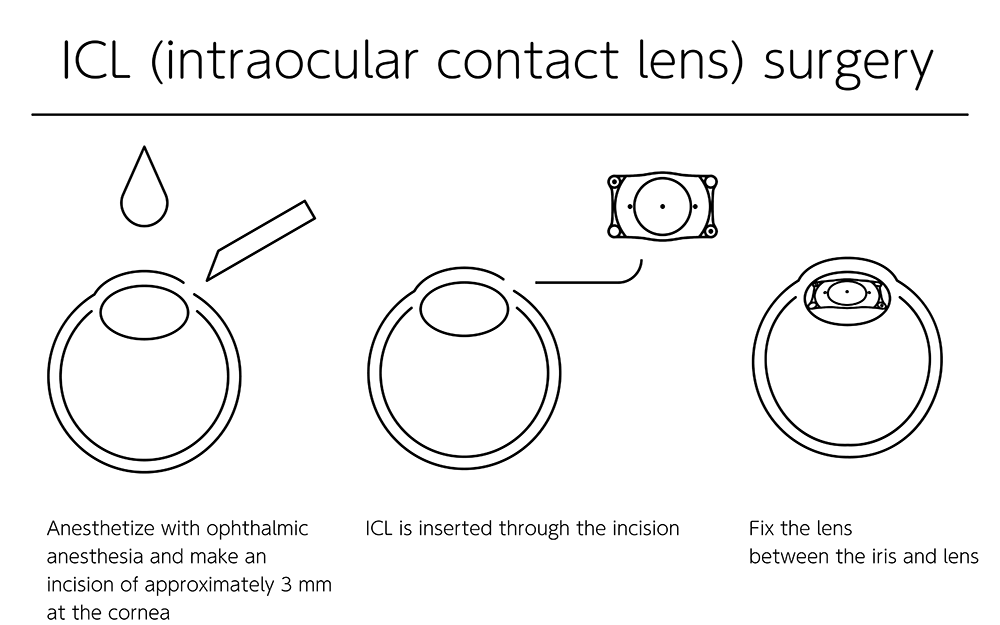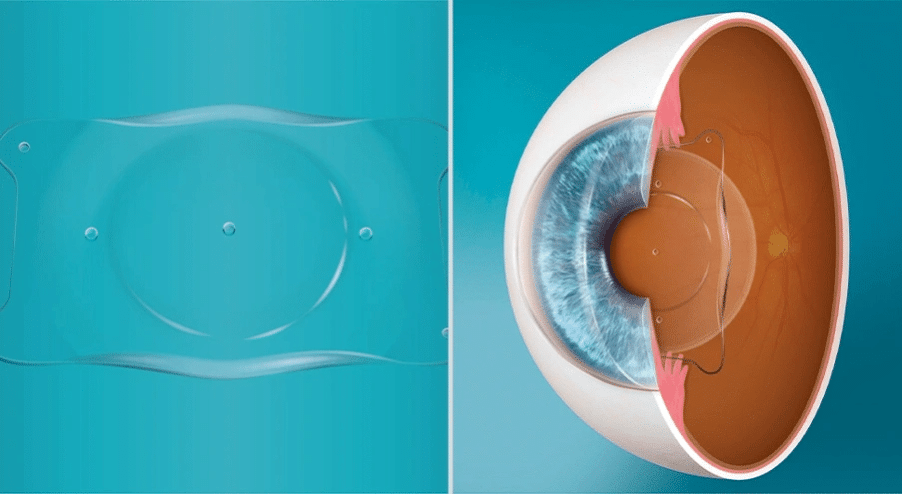Dry eyes after vision correction surgery can be concerning. LASIK remains a prominent procedure, but ICL eye surgery provides a compelling alternative that addresses post-operative dryness concerns. Research shows that post-LASIK dry eye stands as the most common complication after ophthalmic surgeries. This issue deserves attention because dry eye can cause discomfort and affect vision quality.
ICL eye surgery stands out because it doesn’t reshape your cornea. This makes it an excellent choice for patients with thin corneas or dry eye issues. The procedure works by placing an artificial lens between your eye’s natural lens and iris. It effectively corrects nearsightedness between -3.0D to -15.0D and can reduce nearsightedness up to -20.0D. The results speak for themselves – more than 90% of patients achieve 20/20 vision or better.
This piece explains why ICL might be your best solution if dry eye concerns have made you hesitant about vision correction. You’ll learn how ICL works, see how it compares to LASIK regarding dry eye risks, and understand what recovery looks like with this advanced procedure.
Why LASIK Can Lead to Dry Eyes
The way LASIK causes dry eye involves complex changes to your eye’s surface. This knowledge helps explain why other procedures like ICL eye surgery might work better for some patients.

Corneal Nerve Disruption and Tear Film Instability
LASIK surgery changes the corneal structure by creating a flap and removing underlying tissue. This process damages the dense network of corneal nerves. The disruption affects the cornea’s nerve plexus that plays a vital role in tear production. The procedure cuts through both stromal corneal nerves and the subbasal nerve plexus. This leads to less corneal sensitivity and reduced tear production.
The damage to corneal nerves disrupts how the eye surface works with the lacrimal gland. This results in:
- Less stimulation of the lacrimal gland
- Unstable tear film
- Not enough basic and reflex tears
The LASIK flap creation also damages goblet cells that produce mucin—a vital component for stable tear film.
Long-Term Dry Eye Symptoms After LASIK
Dry eye symptoms usually peak in the first few months after surgery. About 20-55% of patients still report eye symptoms six months after the operation. The cornea’s reduced sensitivity starts improving within 6-12 months. However, corneal nerve density might never return to its original levels, even after five years.
Some patients develop chronic neuropathic ocular pain that doesn’t respond to regular dry eye treatments. This condition substantially affects quality of life. Patients with moderate-to-severe dry eye report similar discomfort levels as those with moderate-to-severe angina.
UK-Based Studies on Post-LASIK Dry Eye Prevalence
UK healthcare system research shows that dry eye remains the most common non-refractive complication after laser vision correction. Deeper ablation needed for higher refractive corrections increases the risk of severe dry eye symptoms. Women show a stronger link to severe dry eye scores after LASIK. This might happen because hormones affect tear production. These findings have made full pre-operative assessment of tear function and corneal structure standard practise at specialist centres like Precision Vision London.
ICL Eye Surgery: A Safer Option for Dry Eye Patients
ICL eye surgery helps patients who worry about dry eye complications. This modern procedure has become popular because it’s safe and works well for vision correction.
What is ICL and How It Works
Implantable Collamer Lens (ICL) is a soft, flexible lens made from biocompatible Collamer material that doctors implant inside your eye. The lens sits between your natural lens and iris, unlike laser procedures that remove corneal tissue. The surgery takes just 20-30 minutes through a tiny incision. Your natural lens stays intact, so doctors can reverse the procedure if your vision needs change.

No Effect on Corneal Nerves or Tear Production
ICL surgery stands out because of its unique approach to vision correction. The procedure doesn’t touch your corneal tissue, which protects the nerves that produce tears. Research shows ICL has no adverse effect on the occurrence of postoperative dry eye. This makes it different from other procedures that disrupt corneal nerves and lead to tear film problems.
Ideal for Patients with Pre-Existing Dryness
ICL works best for patients who:
- Have thin corneas or dry eye conditions
- Need to correct high prescriptions (up to -18.00D for short-sightedness)
- Want a reversible vision correction option
ICL gives you crystal-clear vision without risking surgically induced dry eye. This makes it a safer option for people who have existing cornea or eye surface problems.
Comparing LASIK vs ICL for Dry Eye Risk and Suitability
People choosing between vision correction options need to understand the differences to make an informed decision. Let’s look at why many patients choose ICL eye surgery over LASIK, especially those who worry about eye dryness.

Dry Eye Risk: LASIK vs ICL
LASIK surgery directly affects the corneal nerves and causes temporary or persistent dry eye symptoms in about 95% of patients right after surgery. ICL surgery preserves the corneal nerves and helps maintain natural tear production. This makes ICL the better choice for anyone with existing dry eye conditions or those who worry about developing dryness after surgery.
Corneal Thickness Requirements
Your cornea must measure at least 500 microns thick for LASIK to be safe. Patients without enough thickness might develop complications like corneal ectasia. ICL surgery needs no minimum corneal thickness because it doesn’t remove any corneal tissue. This makes ICL a great option for patients with naturally thin corneas that would not qualify for laser procedures.
Prescription Range: Up to -10D vs -20D
LASIK corrects myopia up to -10.00 diopters. Vision correction becomes less effective and riskier beyond this point. ICL can treat nearsightedness between -3.00 and -20.00 diopters. This is a big deal as it means that ICL works better for patients with higher prescriptions.
Reversibility and Long-Term Flexibility
LASIK permanently reshapes the cornea, but ICL offers complete reversibility. Doctors can remove or replace the implanted lens if your vision changes over time or if new vision correction technologies emerge. This flexibility is a huge advantage, especially for younger patients whose vision might still change.
Recovery, Cost, and Patient Experience at Precision Vision London

Patients who want ICL eye surgery often make their decision based on recovery time, cost, and what they can expect from the procedure. Precision Vision London stands out in these significant areas. We provide expert care throughout your vision correction trip.
ICL Eye Surgery Recovery Time and Aftercare
Patients can achieve driving-standard vision within just 2 days after ICL surgery. Your eyes will have protective shields after the procedure. You’ll also get anti-inflammatory, antibiotic, and hydrating drops. The complete one-year aftercare programme has regular post-operative checks that track your visual improvement. In fact, visual recovery happens quickly and patients return to normal activities within 1-2 days.
ICL Eye Surgery Cost in the UK
Precision Vision London‘s ICL surgery costs between £3400-£4150 per eye. This price includes your consultation, the procedure, and the complete aftercare programme. Any enhancement procedure needed to help you achieve your visual goals comes with this cost.
Personalised Consultations and Advanced Diagnostics
Highly trained patient coordinators guide your first steps. You’ll get advanced diagnostics before treatment that include corneal topography scanning and laser biometric tests. We order tailor-made lenses specifically for your eyes after your consultation.
Why Patients Choose Our Expert Surgeons
Dr. CT Pillai leads our team with over 50,000 successful procedures spanning 30+ years. Patient testimonials regularly showcase the exceptional results and personalised care they received.
Comparison Table
| Comparison Factor | LASIK | ICL Eye Surgery |
|---|---|---|
| Dry Eye Risk | High (95% of patients experience symptoms immediately after surgery) | Minimal to none (no adverse effects on postoperative dry eye) |
| Corneal Effect | Damages corneal nerves when creating flap and ablating tissue | No effect on corneal tissue or nerves |
| Vision Correction Range | Up to -10.00 diopters | -3.00 to -20.00 diopters |
| Reversibility | Permanent corneal reshaping | Fully reversible; doctors can remove or replace lens |
| Corneal Requirements | Minimum 500 microns thickness | No minimum thickness needed |
| Procedure Approach | Creates corneal flap and removes tissue | Places lens between natural lens and iris |
| Recovery Period | Takes 6-12 months for nerve recovery | Vision recovers within 1-2 days |
| Long-term Effects | Corneal nerve density might not return to pre-operative levels | No lasting effect on corneal structure |
Conclusion
Patients can see the difference between vision correction procedures more clearly by looking at dry eye syndrome risks. ICL eye surgery emerges as the best choice for anyone worried about dry eyes after surgery. Your eye’s natural tear production stays intact with ICL because it doesn’t affect corneal nerves. This means you won’t get dry eyes from the surgery itself.
ICL shows its real value by correcting prescriptions up to -20.00 diopters. This makes it perfect for people with severe myopia. Patients love knowing they can reverse the procedure if their vision changes later. The best part? You’ll see well enough to drive in just two days – not months like other procedures. Getting the right assessment before vision correction will give you the best results. Precision Vision London’s detailed testing leads to recommendations that match your eye’s specific needs. Dr. CT Pillai and his team have over three decades of expertise. They’ve helped countless patients across the UK with great results.
ICL sets the standard in vision correction for people with thin corneas or existing dry eye problems. It barely touches your corneal structure yet delivers amazing visual results. This makes it the perfect choice to keep your eyes healthy and comfortable for years. Your trip to clear vision starts with a personal consultation. Precision Vision London gives you everything you need – advanced testing, expert surgeons, and complete aftercare. Think about life without glasses or dry eyes. Thousands of happy patients across the UK already enjoy this freedom.
FAQs
Q1. How long does it take to recover from ICL eye surgery? Most patients achieve driving-standard vision within 2 days after ICL surgery. Visual recovery is rapid, with most people returning to normal activities within 1-2 days. A comprehensive one-year aftercare programme includes regular post-operative checks to track visual improvement.
Q2. Is ICL eye surgery suitable for patients with dry eyes? Yes, ICL eye surgery is an excellent option for patients with dry eyes or those concerned about developing dry eye symptoms. Unlike LASIK, ICL surgery doesn’t affect corneal nerves, preserving natural tear production and minimising the risk of post-operative dry eye.
Q3. What is the cost of ICL eye surgery in the UK? ICL eye surgery typically costs between £3400-£4150 per eye in the UK. This all-inclusive price usually covers the consultation, procedure, and complete aftercare programme, including any enhancement procedures required to achieve optimal visual goals.
Q4. Can ICL eye surgery correct high levels of nearsightedness? Yes, ICL eye surgery can effectively treat nearsightedness between -3.00 and -20.00 diopters, making it suitable for patients with higher prescriptions that may not be ideal candidates for LASIK, which typically corrects up to -10.00 diopters.
Q5. Is ICL eye surgery reversible? Yes, ICL eye surgery is fully reversible. The implanted lens can be removed or replaced if vision needs change over time or if newer vision correction technologies emerge. This long-term flexibility is particularly advantageous for younger patients whose vision may continue to evolve.
Authors & Reviewer
-
 Olivia: Author
Olivia: AuthorHi, I'm Olivia, a passionate writer specialising in eye care, vision health, and the latest advancements in optometry. I strive to craft informative and engaging articles that help readers make informed decisions about their eye health. With a keen eye for detail and a commitment to delivering accurate, research-backed content, I aim to educate and inspire through every piece I write.
-
 Dr. CT Pillai: Reviewer
Dr. CT Pillai: ReviewerDr. CT Pillai is a globally recognised ophthalmologist with over 30 years of experience, specialising in refractive surgery and general ophthalmology. Renowned for performing over 50,000 successful laser procedures.

